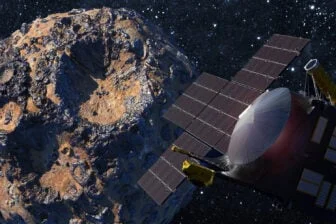
NASA’s Psyche Mission Thrives Despite Thruster Glitch: Switches to Backup Fuel Line
NASA's Psyche mission, aimed at exploring a unique metallic asteroid, faced a critical challenge recently. Just under two years after its launch in October 2023, the spacecraft experienced an unexpected drop in fuel pressure within its propulsion system, jeopardizing its long journey. However, resourceful NASA engineers acted swiftly, implementing a fix that highlights the resilience of the mission and its continued pursuit of the asteroid Psyche.
Earlier in April, engineers detected the pressure drop in the spacecraft's xenon propellant line, falling from 36 psi to approximately 26 psi. This issue demanded immediate attention to ensure the spacecraft remained on course for its rendezvous with the asteroid, scheduled for August 2029. After thorough investigation, the team made a crucial decision: switching from the primary propellant line to an identical backup line. This quick thinking and effective action kept the mission alive.

According to NASA, Psyche's thrusters utilize two large solar arrays to ionize and expel xenon gas, gently propelling the spacecraft through space. Upon detecting the pressure drop, the four electric thrusters were temporarily paused while the team investigated. It was discovered that a component inside one of the valves, responsible for managing propellant flow, had malfunctioned, obstructing the xenon supply to the thrusters. The malfunctioning valve was the culprit.
The switch to the backup fuel line allows the mission to resume its trajectory. Engineers plan to keep the backup line's valve in a permanently open position, mitigating the risk of similar mechanical issues in the future. NASA stated they will command the spacecraft's thrusters to resume firing by mid-June. The team will keep the valve in the open position to ensure propellant flow and avoid any potential mechanical issues in the future.
Psyche is scheduled for a Mars flyby in spring 2026, leveraging the planet's gravity to propel it towards the asteroid belt between Mars and Jupiter. If everything proceeds as planned, the spacecraft will enter orbit around the asteroid Psyche in late July 2029 and begin its mission in August.
This is not the first challenge the Psyche mission has faced. Originally scheduled for launch in 2022, it was delayed due to issues with the spacecraft's flight software. The flight software is crucial for controlling the spacecraft's orientation, trajectory, and communication with Earth. Even a week before its revised launch date, engineers identified a thruster issue that could have led to overheating. These setbacks underscore the complexity of space exploration and the importance of proactive problem-solving. Psyche’s journey highlights the challenges and triumphs of space exploration.

The Psyche asteroid, measuring 140 miles (226 kilometers) in diameter, is believed to be the stripped-down core of a shattered planetesimal. Exploring this asteroid would provide unprecedented insights into the building blocks of planets. Despite the recent setback, the Psyche mission remains on track to potentially revolutionize our understanding of planetary formation.
The successful switch to the backup fuel line underscores the ingenuity and dedication of the NASA team. It also serves as a testament to the value of redundancy in spacecraft design. The mission's continued progress towards the asteroid Psyche offers a beacon of hope for groundbreaking discoveries in the field of planetary science.
What do you think about the challenges of deep-space missions and the ingenuity required to overcome them? Share your thoughts in the comments below!